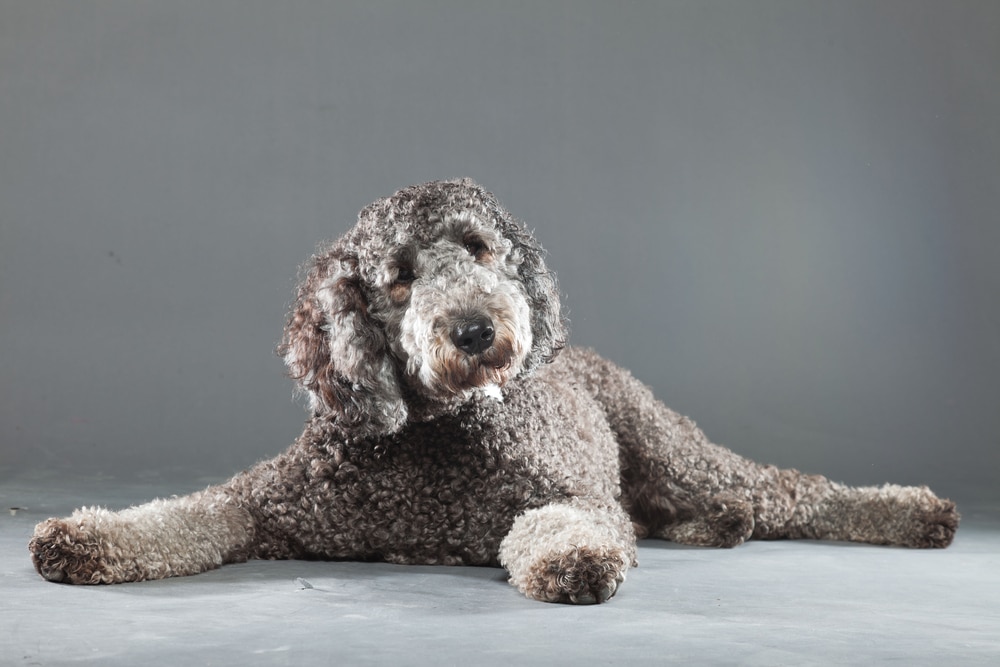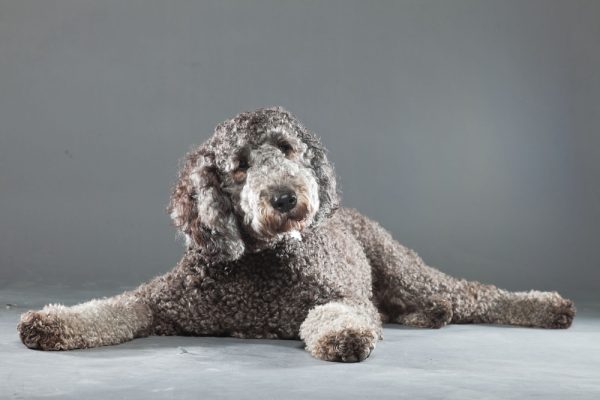Intelligence is only one of the many qualities that drive the Labradoodle’s popularity, but it’s what you want when it’s time to potty train. Teaching your dog the rules of the house takes effort with any breed. New pets are in an unfamiliar environment and likely aren’t used to your expectations. And as you can imagine, puppies rarely come with any sense of boundaries.
Given their trainability, a Labradoodle isn’t any more challenging than the next dog when you need to instill good habits. Still, all dogs are different. Keeping your expectations low and preparing for a lengthy process is always beneficial. Give yourself the best shot at a short training period with our seven tips and tricks to potty-train your Labradoodle.

The 7 Tips to Potty Train a Labradoodle
1. Crate Train
Crate training is the foundation of many potty-training plans, and it does so much for your dog beyond teaching them where to do their business. A crate gives your pet a den and a comfortable retreat to rest. Since it’s their safe space, dogs are inclined to keep it clean.
You can’t keep an eye on your Labradoodle all the time and intervene when they want to potty in the house. The crate is like a constant authority, telling your dog when it’s appropriate when you aren’t around. It’s an enormous aid when you go to bed, run errands, or even leave the room for a few seconds.
Crate Training Tips
Crate training is only as efficient as you make it. Here are some tips for using it to potty train your Labradoodle:
- Buy a crate large enough for your dog to stand, stretch, and turn around but not so spacious that they can urinate in a corner
- Provide toys that are only available in the crate to make your dog excited to use it
- Don’t provide soft bedding or pee pads that might encourage urination
- Never use the crate as a punishment or time-out area
- Keep the crate on a hard floor in case there are any accidents
- Exercise your dog and wait for them to relax before putting them in the crate
- Reward your dog when they stay in their crate, giving them treats when you return
All puppies have a time limit on how long they can hold their bladder, no matter how much they want to keep their crate clean. You must still pay attention to how long it has been since your dog went to the bathroom and take them out when they indicate they need to go.

2. Be Aware of the Bladder Size
As you monitor the time between bathroom breaks, you must consider the dog’s bladder size. Puppies can only hold it for so many hours. Like raising a baby, expect your young dog to do their business every few hours, day and night, if you want to maintain a clean crate and accident-free house.
Puppies can generally hold their pee for one hour for every month of age (e.g., a 4-month-old puppy can hold it for about 4 hours). Depending on the size of your Labradoodle, they may be able to go slightly longer.
It would be best if you habitually took your dog out every few hours, even after bedtime. At about 6 months old, they should be able to hold their bladder through the night.
3. Don’t Get Angry
Peeing and pooping in the wrong place is the worst part of waking up with a puppy. It puts you in a bad mood and on the verge of exploding on your dog. All too often, dog owners are quick to anger, letting their emotions push them to stick their dogs’ faces in the mess and yell at them. But cathartic as it may seem, it does nothing to improve the situation.
When your Labradoodle is outside, they must be comfortable going potty around you. Showing anger when they pee inside may make them afraid of ever doing their business in front of you out of concern that you may react negatively. They don’t necessarily understand the nuance between outdoors and indoors. All they see is their owner getting mad because they go to the bathroom, and they’ll try to avoid that as much as possible.
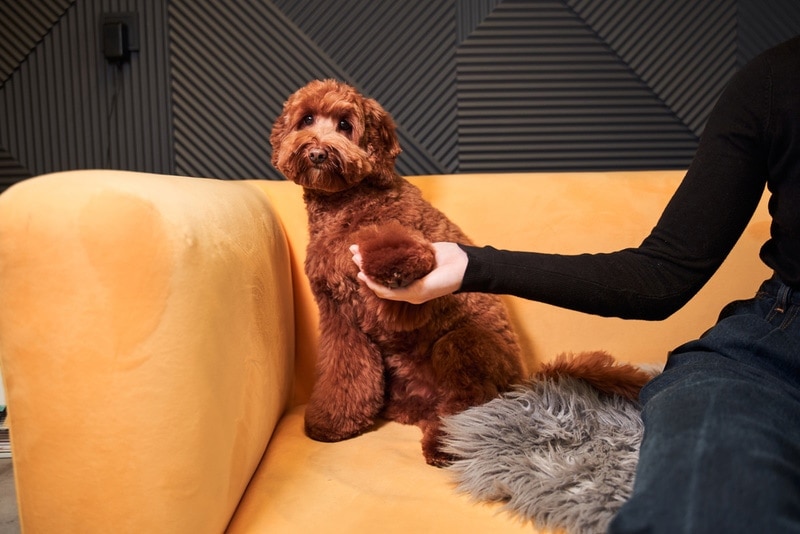
4. Keep an Enzyme Cleaning Spray Available
Accidents are bound to happen, and you’ll have to clean them thoroughly to prevent repeat performances. If your Labradoodle maintains their scent in a particular spot, they’ll only find a reason to keep urinating there.
Labradoodles have a keen sense of smell, and sufficiently removing the urine odor in carpeting takes more than white vinegar and baking soda. An enzymatic cleaner is the best product to remove the scent and prevent your dog from going to the bathroom on the rug.
Products like Rocco & Roxie Stain & Odor Eliminator use bacteria and enzymes to consume every trace of organic waste. They are safe to use around people and pets and continue working until they break down every odor-causing molecule, ensuring your Labradoodle puppy doesn’t establish a familiar bathroom spot.
5. Give Your Puppy Some Extra Time Outside After Pottying
House training a Labradoodle puppy can take months of diligent work. Although you can’t skimp on training, you can save time and effort. For several reasons, one of the best ways to facilitate the process is to give your dog extra time outside after using the bathroom.
Puppies don’t always have the easiest time emptying their bladder in one round of peeing. Minor accidents will be more common if you take them inside immediately after they go potty. We want to keep indoor elimination to a minimum, so taking a few extra minutes outside to let them relieve themselves completely can be an enormous help.
Some people also exercise or play with their dog after they go to the bathroom, which may work for an active breed like a Labradoodle. Burning off energy can also set them up for better rest when they return to the crate.
Playing like this can act as a reward, encouraging quicker peeing when you take them outside. It doesn’t work for every dog, so the foundation of your reward system should still be a treat and a marker immediately after they pee or poop in the desired spot.
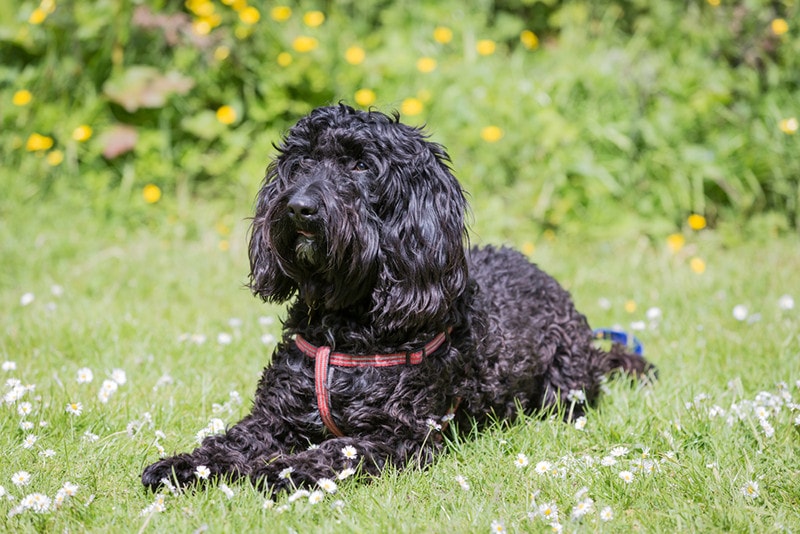
6. Limit Your Dog’s Access to Other Rooms
When potty training your Labradoodle, maintaining constant control of the situation is vital. You must be able to supervise your dog at all times and respond when it’s time to go to the bathroom. Keeping them leashed inside is one option, but you can make life easier by confining your dog to a limited space.
Set up dog gates and fences to prevent your Labradoodle puppy from wandering out of sight or hiding a urine spot in another room. You’ll have an easier time identifying stains and cleaning up after your dog if they have a random accident. More importantly, your dog will have fewer chances to go to the bathroom in the first place because you’ll always have eyes on them.
7. Watch for the Signs
Your dog won’t tell you outright that they need to go to the bathroom, but you can watch for classic signs that it’s time for a walk. They may put their nose to the ground or start walking in circles, mentally preparing a suitable spot. Their actions might shift suddenly. If they sit up abruptly or stop playing with a toy, they could have a sudden urge to pee that needs immediate attention.
Sometimes, your Labradoodle makes it easy for you. Pacing around the door is a positive sign, as your dog shows they know where they need to go. No matter what, dogs have unique communication habits, and it’s up to you to figure out which signals indicate the urge to pee.
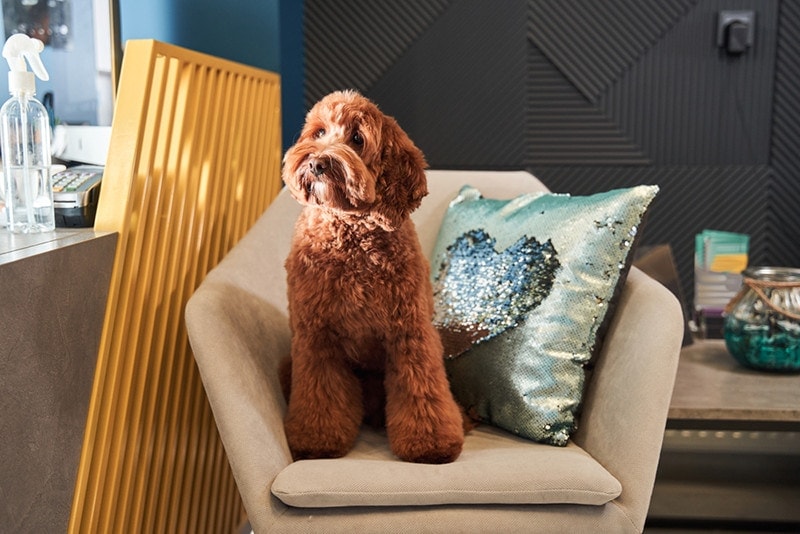

How Long Does It Take to Potty Train a Labradoodle Puppy?
As with any dog, patience is crucial in potty training a Labradoodle. Taking your time and appreciating the effort involved will help you make the experience as positive as possible for your dog. But it will also help you speed up the training process.
When you’re patient, you’ll be more active in monitoring your dog, which means you’ll be more responsive. Keeping accidents out of the house reinforces the association between bathroom breaks and being outside. You’ll spend less time correcting the wrong behavior and more time encouraging the right one.
A Labradoodle may need only a few weeks to dial in their potty habits, while others may require over five months of training. There’s no way to predict how long it will take, but you also have some agency. Patience, consistency, and constant care will give you the best chance of training them in weeks rather than months.

Conclusion
Potty training has its frustrations, but in many ways, it’s one of the joys of ownership. You can feel proud of a well-behaved puppy, and they can rejoice in pleasing you. Keep it an overall positive process, stay patient and proactive, and you’ll have no problem establishing perfect potty habits in your Labradoodle.
Featured Image Credit: Studio_Shot, Shutterstock
Contents
- The 7 Tips to Potty Train a Labradoodle
- 1. Crate Train
- 2. Be Aware of the Bladder Size
- 3. Don’t Get Angry
- 4. Keep an Enzyme Cleaning Spray Available
- 5. Give Your Puppy Some Extra Time Outside After Pottying
- 6. Limit Your Dog’s Access to Other Rooms
- 7. Watch for the Signs
- How Long Does It Take to Potty Train a Labradoodle Puppy?
- Conclusion

